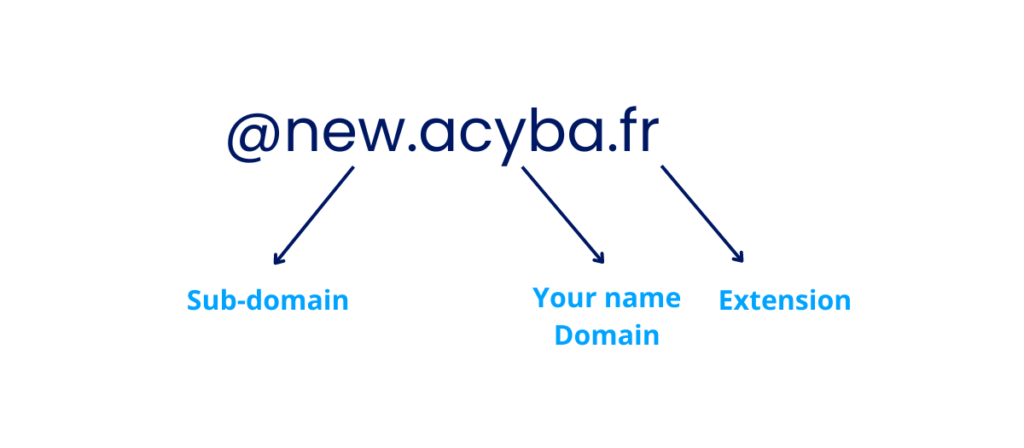Discover why using sub-domains is a winning idea!
🔎 What are domains and sub-domains?
An email address domain name is the part of an email that comes after the @ symbol. For personal emails, this is usually gmail.com, yahoo.com or outlook.com. However, in a business context, almost all companies have their own domain name.
A sub-domain is an extension of the base domain. For example, if the domain name is new.acyba.fr, the particle “new” is the subdomain. Sub-domains are essential for establishing a solid sending reputation for your different types of email.

Using sub-domains can help you minimise potential domain reputation problems and ensure that your mail arrives where you want it.
🤓 Why use a sub-domain?
Using a sub-domain name for email campaigns can be beneficial for several reasons:
- Avoid being blacklisted: Email service providers often have strict policies regarding spam and email abuse. If a large quantity of emails sent from a main domain is reported as spam, this can result in that domain being blacklisted. By using specific sub-domains for your email campaigns, you reduce the risk of your main domain being affected in the event of complaints about these campaigns.
- Separate marketing activities: By using separate sub-domains for your email campaigns, you can better segment and control your marketing activities. This means you can manage the performance of each campaign more effectively, as well as personalise and tailor content to your audience segments.
For example, if you want to tell your users about an update to your blog page, you can use the subdomain “blog”: blog.acyba.com. This gives you better control over the reputation of your domain. This is also an industry best practice that we highly recommend.
- Improve sender reputation: Sub-domains specific to email campaigns can establish a distinct sender reputation. This means that spam filters and email provider algorithms will treat your emails according to the reputation of each sub-domain. If you manage these sub-domains correctly and maintain a good sender reputation, this can help to improve the deliverability of your emails.
- Testing and optimisation: By using sub-domains for different campaigns, you can conduct A/B tests and other analyses to assess the effectiveness of different marketing approaches. This allows you to optimise your campaigns for best results.
📚 A few use cases for a better strategy:
Here’s how you can use sub-domains for different types of emailing to optimise your strategy:
- Transactional emails :
- Subdomain: transactional.yourdomain.com
- Strategy: Transactional emails include order confirmations, account notifications, password resets and so on. By using a dedicated sub-domain for these emails, you ensure fast and reliable deliverability. You can also customise the security and deliverability settings specifically for these types of emails.
- Batch shipments :
- Subdomain: marketing.yourdomain.com
- Strategy: Batch mailings include newsletters, promotions and special announcements. By using a separate sub-domain for these mailings, you can better control sender reputation and prevent marketing activities from affecting the deliverability of important transactional emails.
- Blog articles :
- Subdomain: blog.yourdomain.com
- Strategy: If you send out newsletters containing blog posts or content updates, a specific sub-domain can be used to strengthen the association between your blog and your emails. This can also help measure subscriber engagement with your blog content.
- Company emails :
- Subdomain: company.yourdomain.com
- Strategy: Corporate emails include internal communications such as company announcements, employee newsletters, etc. By using a dedicated subdomain, you can keep these communications separate from other types of email. By using a dedicated sub-domain, you can keep these communications separate from other types of email, making it easier to manage and track their performance.
By using specific sub-domains for each email type, you can effectively segment your marketing activities, maintain a better sender reputation, customise deliverability parameters and track the performance of each email category more accurately. This contributes to a more organised, targeted and effective emailing strategy overall.
🔚 To conclude
Using sub-domains to send emails is a wise strategy for several reasons.
Firstly, it avoids being blacklisted in the event of deliverability problems or complaints relating to specific campaigns. By separating marketing activities via dedicated sub-domains, you can better control sender reputation and optimise email deliverability.
In addition, this approach makes it easier to personalise and adapt content according to audience segments, which improves engagement and conversion rates. Finally, the use of sub-domains enables more precise testing and analysis to optimise campaign performance. In short, this strategy contributes to more efficient management, better deliverability and more convincing results in the field of email marketing.
also read : best time and day to send email newsletters in 2023



